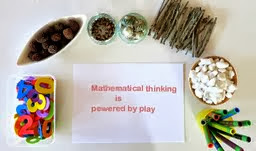This is an interesting game that was introduced to the class. Two players will be holding a card facing each other. Using multiplication, the third person will give the product of the two numbers. The ones who were holding the card need to guess the number she is holding. We have so much fun with the game and fail to realize we are actually doing multiplication.That's awesome because it will eliminate the process of rote learning. Our group extend this experience by trying on addition and subtraction and we have a whale of time!!
It has been a week loaded with many new numeracy experiences that give me different perspectives of learning maths.Throughout this math journey, Dr Yeap showed us that there are many ways to solve a problem and the importance of peer interactions. We witnessed how important for children to have concrete materials in their learning of concepts.Through exploration and experimenting with these concrete materials, children will begin thinking abstractly.




.jpg)
.jpg)



















